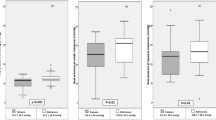Abstract
Purpose
The aim of this paper was to assess the clinical value of anorectal manometry (ARMM) in the diagnosing of Hirschsprung’s disease (HD) in neonates.
Methods
From January 2003 to June 2005, 75 patients in whom HD was clinically suspected were analyzed. ARMM was performed using a desk, high rate gastrointestinal dynamic detection system and the results were compared with barium enema and rectal suction biopsy.
Results
Based on rectal suction biopsies in 52 of 75 patients, the positive, false positive, negative, and false negative rates of ARMM in the diagnosis of HD in neonates were found to be 92.3, 1.9, 1.9, and 3.8%, respectively. Forty-three of 75 patients were diagnosed with HD by both ARMM and barium enema and the diagnoses were validated by pathologic results. The diagnosis of HD was excluded in 18 patients in whom HD was clinically suspected, but in whom the results of ARMM and barium enema were normal. Twelve patients who had ARMM results consistent with HD and a negative barium enema, had serial ARMM performed; a rectoanal inhibitory reflex (RAIR) was elicited in four patients, thereby excluding HD and the remaining eight patients were diagnosed with HD by review of barium enema and pathologic results. One of two patients with a positive barium enema for HD, but an ARMM showing the presence of RAIR was excluded by pathologic results and the other patient was lost to follow-up. The diagnostic accuracies of ARMM and barium enema for HD in neonates were 93.3 and 86.7%, respectively. There was no difference in rectal resting pressure and anal rhythmic wave frequency between neonates with HD and healthy neonates, but neonates with HD had higher anal sphincter pressures than healthy neonates (P = 0.0074).
Conclusions
ARMM is a simple, safe, and non-invasive method with high specificity for the diagnosis of HD in neonates.


Similar content being viewed by others
References
Russell MB, Russell CA, Niebuhr E (1994) An epidemiological study of Hirschsprung’s disease and additional anomalies. Acta Paediatr 83:68. doi:10.1111/j.1651-2227.1994.tb12955.x
Spouge D, Baird PA (1985) Hirschsprung’s disease in a large birth cohort. Teratology 32:171. doi:10.1002/tera.1420320204
Ross MN (1988) Complications of the Martin procedure for total colonic aganglionosis. J Pediatr Surg 23:725. doi:10.1016/S0022-3468(88)80411-1
Sherman JO (1989) A 40-year multinational retrospective study of 880 Swenson procedures. J Pediatr Surg 24:833. doi:10.1016/S0022-3468(89)80548-2
Mi-zu J, Xue-lian Z, Shan X et al (2001) The application of anorectal manometry in diagnosis of Hirschsprung’s disease in children. Zhe Jiang J 30:178–179
Xue-lian Z, Fei-bo C, Bi-you O et al (2004) Evaluation of clinical value of anorectal manometry for diagnosis of Hirschsprung’s disease in neonate. Chin J Pediatr 42:681–683
De Lorijn F, Omari T, Taminiau JAJM et al (2003) Maturation of the rectoanal inhibitory reflex in very premature infants. J Pediatr 143:630–633. doi:10.1067/S0022-3476(03)00497-9
Benninga MA, Omari TI, Haslam RR et al (2001) Characterization of anorectal pressure and the anorectal inhibitory reflex in healthy preterm and term infants. J Pediatr 139:233–237. doi:10.1067/mpd.2001.115969
Wang W, Yuan Z, Wang W et al (2002) Diagnosis and treatment of the dysporia disease in children. People and Health Press, Beijing, p 28
Pini Prato A, Martucciello G, Jasonni V (2001) Solo-RBT: a new instrument for rectal suction biopsies in the diagnosis of Hirschsprung’s disease. J Pediatr Surg 36:1364–1366. doi:10.1053/jpsu.2001.26370
Martucciello G, Pini Prato A, Puri P et al (2005) Controversies concerning diagnostic guidelines for anomalies of the enteric nervous system: a report from the fourth international symposium on Hirschsprung’s disease and related neurocristopathies. J Pediatr Surg 40:1527–1531. doi:10.1016/j.jpedsurg.2005.07.053
Author information
Authors and Affiliations
Corresponding author
Rights and permissions
About this article
Cite this article
Huang, Y., Zheng, S. & Xiao, X. Preliminary evaluation of anorectal manometry in diagnosing Hirschsprung’s disease in neonates. Pediatr Surg Int 25, 41–45 (2009). https://doi.org/10.1007/s00383-008-2293-7
Accepted:
Published:
Issue Date:
DOI: https://doi.org/10.1007/s00383-008-2293-7




